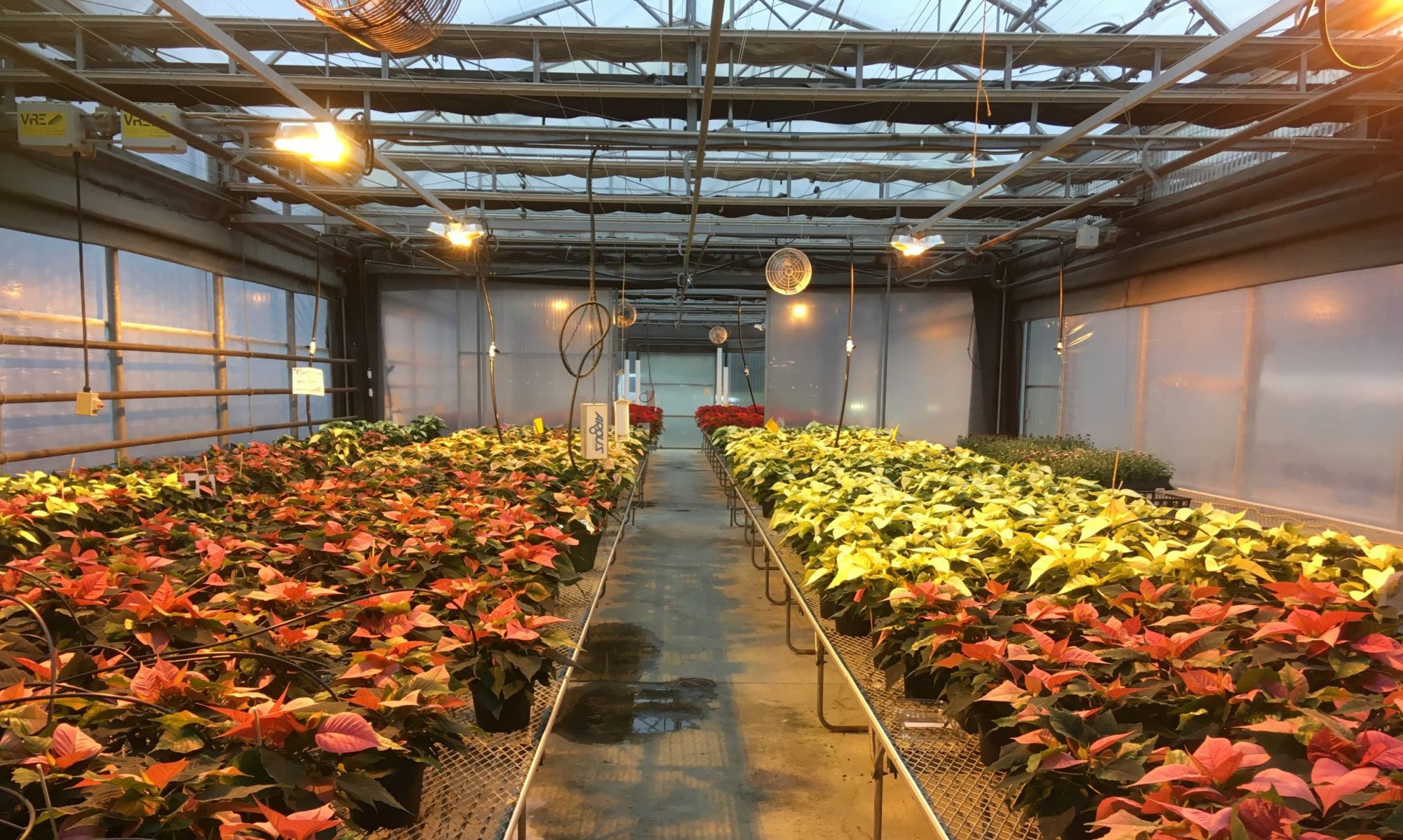Week Number: 43
It is time to promote our poinsettia sale! If you know someone looking to add some colourful cheer to their space this holiday season you can direct them to our online order form on our website:
https://tradesappliedtech.viu.ca/horticulture/form/poinsettias
Environmental Conditions:
Week 43 had much outside day and night averages compared to week 42. We had some days with high solar radiation however, mostly cloudy weather which required us to use the supplemental lighting in the greenhouses. Night temperatures dropped to 4C this week and we anticipate below freezing night temperatures for the first time this fall over the weekend.
Day: Heating Setpoint 20C | Cooling Setpoint 22C
Night: Heating Setpoint 18C | Cooling Setpoint 20C
Continuing our temperature regime from last week, we used Argus Controls to create two distinctive temperature zones. Our day period, which corresponds directly to our literal (or solar) day period (light is getting to the crop) is running higher than our night period; this means we are running a positive diff. A negative diff is if we were running a warmer night period than day period.
We need to ensure a greater and distinct difference between the day and night temperatures to help trigger generative growth. Its important to remember that our temperature zones are dynamic, and we can change the, based on our height measurements and our visual inspections of our crop. This week the students determined what no change should take place with regards to our temperature regime in the greenhouse based on the height tracking information.
Supplemental Lighting:
We are running a 9-hour day and a 15-hour night to trigger the plants into generative growth. This is essentially what is going to turn our poinsettias red, white, or pink. We are currently in week 3 of our blackout period.
Hours of Black Out: 15 hours – 5pm to 8am.
Nutrient:
EC target is 1.5 – 2.0 pH target is 5.7 – 6.3
EC: The EC’s ranged from 0.4 – 1.6 again this week.
pH: We are starting to see an upward trend in the pH which is a good sign since last week the pH was concerningly low. We also switched from the Mg fertilizer to the CaN03 fertilizer to continue developing the roots and help bract development. This week we will continue to focus on looking for nutrient deficiencies in our crop. Refer to VIULearn for resources.
Watering/Fertilizer:
The students assessed soil moisture on Tuesday in our face to face classes and determined that only two (2) flood tables containing 4” plants required water. Our flood table systems are drain to waste, meaning we do not recirculate the water draining out of the plant pots.
In addition to the EC measurements we used the plant heights to guide us towards our decision on what (if anything) we should water with. Our plants are sitting around 26cm on average and this information helps us decide what, if anything, to fertilizer with.
Now that we have started the black out it is increasingly important to be accurate in our poinsettia height measurements. Once we have triggered generative growth the plants will start to focus their growth on generative and less towards vegetative growth meaning we have less flexibility when adjusting temperatures to direct crop height.
Observations:
- We have been working to complete the irrigation set up in the greenhouses and all, but two (2) benches are finished. The 4” poinsettias in the flood table are looking crowded already as they grow into the surrounding space. We will work towards changing this system in week 44.
- The students have been taking weekly height measurements and we can see that our crop is (generally) increasing in height each week. Its critical we use correct height measuring techniques to use the most accurate information to base our decisions from. Our crop average is 28.8cm, which is 1.5cm taller than last week.
- We created two distinct temperature zones (see above) which will help in triggering our plants into generative growth. We assessed the plant heights in our face to face class this week and determined that we are on trend to finishing our plants at our desired height of 40cm-42cm. We decided to keep the temperature regime the same for this week. The students decided to not change environmental conditions in the greenhouse this week based on the height measurements because they determined they are on track to finish at the desired final height.
- Team Grow Getters were in the greenhouses this week and participated in lab #1 of the yellow sticky card assignment. As a class the team determined thresholds for pest insects in the greenhouse including fungus gnats and whitefly. The class collectively determined we should apply a biological control and chose to apply beneficial insects like Encarsia formosa for whitefly and Hypoaspis miles for fungus gnats. due to the high pest pressures. The biological controls have been ordered and we hope they will arrive in time for class on Tuesday, October 27.
- This week a VERY exciting change happened in the greenhouse! We spotted the first signs of colour change in the crop. You can see from the pictures below that the change occurs in splotch-like pattern in between the veins on the leaves. Interestingly, in cultivars like Titan Pink, the colour change is starting as a pinkish hue in the petioles. We anticipated that colour change should happen in week 3 and we are right on target! Great job everyone!
- Moving forward it will be critical to manage greenhouse environment and pest pressure to ensure crop health throughout the next 7.5-8 weeks until sales. Speaking of sales, it is time to turn our focus to selling our crop! Please look at the week 41 section of VIULearn for updated sale information. Our online order form is ready to take orders through our website at
https://tradesappliedtech.viu.ca/horticulture/form/poinsettias
3. Later progression (Friday, October 23) of colour change in Carina Hot pink.






